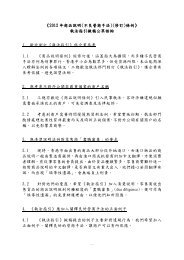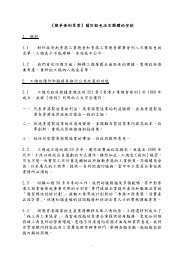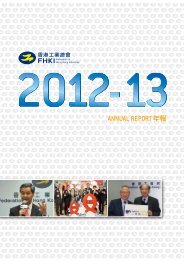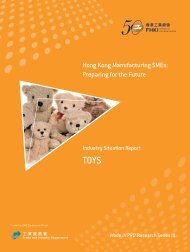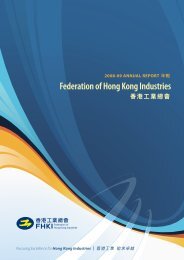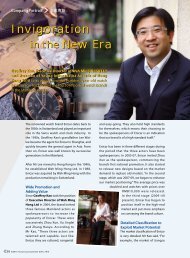Hong Kong Manufacturing SMEs: Preparing for the Future
Hong Kong Manufacturing SMEs: Preparing for the Future
Hong Kong Manufacturing SMEs: Preparing for the Future
- No tags were found...
You also want an ePaper? Increase the reach of your titles
YUMPU automatically turns print PDFs into web optimized ePapers that Google loves.
65• Having a manufacturing base in Mainland Chinamay make <strong>the</strong> SME more competitive, as will <strong>the</strong>continued automation of firm processes that arelabour intensive.• Creating loyal customers will pay back duringtough times. Loyal companies may do things likearrange letters of credit <strong>for</strong> <strong>the</strong> firm to use tofinance its operation during <strong>the</strong> short-term.• <strong>SMEs</strong> must work to understand <strong>the</strong> needs of<strong>the</strong>ir partners as well as <strong>the</strong>ir customers.• <strong>SMEs</strong> can develop and maintain a technologicaladvantage by ensuring that <strong>the</strong>ir research anddevelopment team is well-trained and thatits skills are regularly updated. Research anddevelopment staff need to be motivated andincentivised just like o<strong>the</strong>r staff. Motivationcan come in many <strong>for</strong>ms including throughparticipation in competitions.• <strong>SMEs</strong> need to plan. They should set strategiesand review <strong>the</strong>m regularly.• Meetings with <strong>the</strong> senior management teampresent an opportunity <strong>for</strong> cross-functionalcollaboration between different business units.Such collaborations have <strong>the</strong> potential to bringabout material improvements in <strong>the</strong> business.• Teamwork is important. To create a strong team,<strong>the</strong> firm should treat employees as partners in <strong>the</strong>business and that <strong>the</strong> same respect and loyaltyshould be shown to <strong>the</strong>m that one would showto one’s family.• Failure can be a lesson on how <strong>the</strong> firm canimprove. Although a short-term problem mayaffect short-term profit, a lesson well learned mayhave a greater positive impact on long-term profit.• Focusing on <strong>the</strong> short-term is often <strong>the</strong> wrongthing to do. Many of <strong>the</strong> problems that firmsface are due to attempts to maximise profit ona short-term basis. This can lead to disharmonywith staff, customers, and o<strong>the</strong>r importantstakeholders that <strong>the</strong> business depends on <strong>for</strong> itslong-term success.• Integrity and reputation are all-important tosuccess in <strong>the</strong> industry. Both qualities are hardwon and, if lost, are even harder to regain.The Garment IndustryThe garment industry consists of fashion design,apparel manufacturing, clo<strong>the</strong>s wholesale, andretailing. The global garment industry’s totalrevenue in 2006 was US$1,253 billion. This isestimated to reach a value of US$1,782 billion by<strong>the</strong> end of 2010. 126China is <strong>the</strong> largest producer and consumer ofgarments, producing over 50 per cent of <strong>the</strong> world’stotal in 2008. Guangdong Province is <strong>the</strong> largestgarment producer in China, accounting <strong>for</strong> 18.3 percent of total reported Gross Industrial Output (GIO)in garments in China in 2008 (ahead of Zhejiang,Jiangsu, Shandong, and Fujian). It is reportedthat <strong>the</strong>re are over 30,000 garment enterprises inGuangdong in 2009 and about 80 per cent of <strong>the</strong>seenterprises are mainly export-oriented. 127 The 2009Guangdong Statistical Yearbook reports that <strong>the</strong>garment sector in Guangdong accounted <strong>for</strong> 1.1million workers, GIO of RMB 172.5 billion, exportsof US$23.9 billion, imports of US$823.5 million,and VAT of RMB 5.6 billion in 2008. Garmentmanufacturing is concentrated in <strong>the</strong> PRD, especiallyin Dongguan, Zhongshan, and Foshan.<strong>Hong</strong> <strong>Kong</strong> firms are a leading global <strong>for</strong>ce in <strong>the</strong>industry. Several of <strong>the</strong> world’s leading garmentfirms are headquartered in <strong>Hong</strong> <strong>Kong</strong> and it hasbeen estimated that <strong>Hong</strong> <strong>Kong</strong> firms control on<strong>the</strong> order of a quarter or more of world garmenttrade. <strong>Hong</strong> <strong>Kong</strong> companies generally look afterstrategy, coordination, marketing, and financefrom <strong>Hong</strong> <strong>Kong</strong>, while producing in <strong>the</strong> Pearl RiverDelta and elsewhere. <strong>Hong</strong> <strong>Kong</strong> companies startedmoving production into <strong>the</strong> PRD in <strong>the</strong> 1980s andlittle production remains in <strong>Hong</strong> <strong>Kong</strong>. The vastmajority of <strong>Hong</strong> <strong>Kong</strong> garment companies, largeas well as small, are engaged in OEM production<strong>for</strong> well-known brands and retailers such as Armani,126 www.fashionproducts.com.127 gcontent.nddaily.com.




